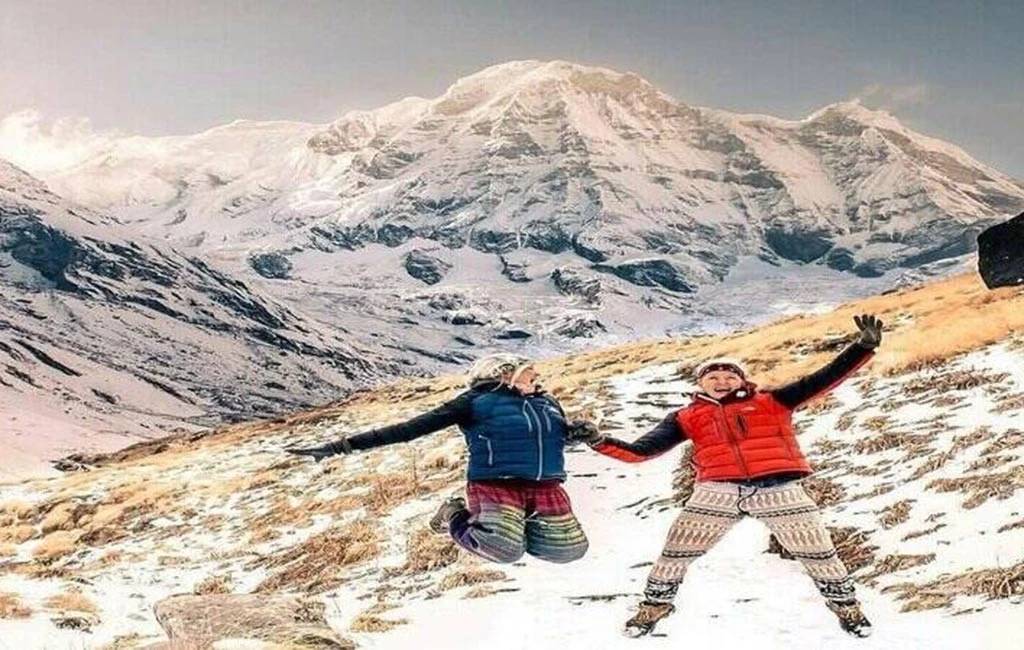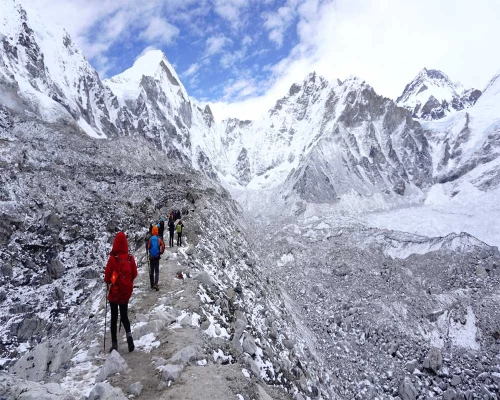Everest Base Camp Trek
The Everest Base Camp (EBC) trek is one of the most sought-after trekking encounters in the world. Found in the heart of the Himalayas, this trek offers unparalleled views of Mount Everest (8,848.86m) and other staggering peaks like Lhotse, Nuptse, and Ama Dablam. The trip starts in Lukla, a little mountain town that serves as the door to the Everest region. From there, trekkers pass through Namche Bazaar, the bustling Sherpa capital, and proceed through excellent rhododendron woodlands, suspension bridges, and religious communities some time recently coming to Everest Base Camp at 5,364m.
The trek moreover incorporates a climb to Kala Patthar (5,545m), a vantage point advertising breathtaking all encompassing views of Everest and the encompassing mountains. Along the way, trekkers experience Sherpa culture, visit religious communities such as Tengboche Religious community, and encounter the special way of life of the Himalayan individuals. The tall elevation and tough territory make this a challenging however fulfilling enterprise for trekkers worldwide.

Annapurna Base Camp Trek
The Annapurna Base Camp (ABC) trek is one of the most beautiful and fulfilling treks in Nepal. It takes travelers through different scenes, from lavish green woodlands to snow capped glades and at last to the base of the towering Annapurna Massif. The trek starts in Pokhara, a pleasant city known for its quiet lakes and dazzling mountain views. Trekkers pass through towns like Ghorepani, Tadapani, Chhomrong, and Machapuchare Base Camp, where they can witness the excellence of the Annapurna and Dhaulagiri ranges.
One of the highlights of this trek is Poon Slope (3,210m), which offers a breathtaking dawn view over the Himalayas. The trek comes full circle at Annapurna Base Camp (4,130m), encompassed by the forceful peaks of Annapurna I (8,091m), Annapurna South, Hiunchuli, and Machapuchare (Fishtail). Not at all like the Everest Base Camp trek, the ABC trek has a more direct height and less dangers of elevation affliction, making it an amazing choice for apprentice and experienced trekkers alike.
Annapurna Circuit Trek
The Annapurna Circuit trek is one of Nepal’s most celebrated and different treks, advertising trekkers an extraordinary journey through changing scenes, societies, and elevations. This trek encompasses the whole Annapurna run, beginning from the lavish green valleys of Besisahar and passing through Manang, Thorong La Pass, Muktinath, and Jomsom some time recently plummeting into the Kali Gandaki Glut, the world’s most profound gorge.
The trek’s highlight is crossing the Thorong La Pass (5,416m), the most elevated point of the trip, which offers breathtaking views of the Annapurna and Dhaulagiri mountain ranges. Trekkers too get to involve the social differing qualities of Nepal, from the Hindu towns in the lower region to the Tibetan-influenced Buddhist culture of Manang and Colt. The trek closes in Pokhara, making it a culminating mix of enterprise and social immersion.
Everything You Need to Know Before You Go
Highlights
Everest Base Camp trek: Sees of Mount Everest, Kala Patthar summit, Tengboche Religious community, Namche Bazaar, Sherpa culture, and Sagarmatha National Park.
Annapurna Base Camp trek: Annapurna Massif sees, Machapuchare Base Camp, Poon Slope dawn, assorted vegetation and fauna, and warm neighborliness of the Gurung people
Annapurna Circuit trek: Thorong La Pass, social encounters in Manang and Colt, Muktinath sanctuary, Kali Gandaki Glut, and normal hot springs at Tatopani.
Food
During all three treks, trekkers can appreciate an assortment of Nepali and worldwide food. The most common feast is Dal Bhat (rice, lentil soup, vegetables, and pickles), which gives a bounty of vitality. Other nourishment choices include:
Everest Base Camp trek: Tibetan bread, momos (dumplings), Sherpa stew, noodle soup, and apple pie.
Annapurna Base Camp trek: New vegetables, fricasseed rice, pasta, hotcakes, and nearby dairy products.
Annapurna Circuit trek: Thukpa (Tibetan noodle soup), yak cheese, buckwheat bread, and locally brewed tea.
Since nourishment is carried up by watchmen or yaks, costs increment with height. It is prudent to carry a few high-energy snacks such as chocolate bars, nuts, and vitality drinks.
Best Time
The best time for these treks is amid spring (March-May) and harvest time (September-November). Amid these seasons, the climate is steady, with clear skies and staggering mountain views.
Spring (March-May): The trails are filled with blooming rhododendrons, and temperatures are moderate.
Autumn (September-November): Crystal-clear sees, mellow temperatures, and happy trekking atmosphere.
Winter (December-February): Greatly cold at tall elevations but less crowded.
Monsoon (June-August): Overwhelming downpours, leeches, and dangerous trails, but lavish green scenes in lower regions.
Cost and Package
The toll of these treks depends on variables such as grants, direct and doorman administrations, convenience, and term. Underneath is an evaluated taken a toll breakdown:
Everest Base Camp trek: $1,200 – $2,500 (counting grants, flights, guides, doormen, and food).
Annapurna Base Camp trek: $800 – $1,500 (counting licenses, transportation, and accommodation).
Annapurna Circuit trek: $900 – $2,000 (depending on whether you take transportation or trek the full route).
Permits required:
Everest Base Camp: Sagarmatha National Stop Passage permit and Khumbu Pasang Lhamu Rustic District Permit.
Annapurna Base Camp and Circuit: Annapurna Preservation Range permit (ACAP) and TIMS (Trekkers’ Data Administration Framework) card.
Tips for a Successful Tour
Acclimatize properly – Take rest days at higher rises (e.g., Namche Bazaar and Manang) to anticipate elevation sickness.
Train in development – Construct perseverance through cardiovascular works out, quality preparing, and climbing with a stacked backpack.
Pack admirably – Fundamentals incorporate trekking boots, warm layers, a resting pack, sunscreen, and water decontamination tablets.
Stay hydrated and eat well – Legitimate hydration and sustenance offer assistance to avoid height sickness.
Hire a guide and porter – Guides guarantee security, and watchmen offer assistance carrying overwhelming loads, making the trek more enjoyable.
Respect nearby culture – Be careful of traditions, dress unassumingly, and welcome local people with “Namaste.”
Get travel protections – Guarantee your protections covers high-altitude trekking and crisis evacuation.

Conclusion
The Everest Base Camp trek, Annapurna Base Camp trek, and Annapurna Circuit trek each offer interesting encounters for trekkers looking for enterprise in the Himalayas. Whether you select to stand at the foot of Everest, walk through the Annapurna Haven, or circle the magnificent Annapurna extend, these treks give staggering scenes, social experiences, and a profound sense of achievement. Legitimate arranging, physical arrangement, and mindfulness of altitude-related challenges will guarantee an effective and exceptional trekking involvement in Nepal.
FAQs
Which trek is the most difficult?
Everest Base Camp and Annapurna Circuit are more challenging due to elevation, whereas Annapurna Base Camp is moderately easier.
Do I require a guide?
Hiring a direct is suggested for security and superior route, particularly in inaccessible areas.
What is the most elevated elevation reached?
Everest Base Camp (5,364m), Kala Patthar (5,545m), Thorong La Pass (5,416m), Annapurna Base Camp (4,130m).
How long does each trek take?
Everest Base Camp: 12-14 days, Annapurna Base Camp: 7-12 days, Annapurna Circuit: 14-21 days.
Is elevation affliction common?
Yes, legitimate acclimatization, hydration, and moderate climb are pivotal to dodging elevation affliction.
Contact Us Himalayan Recreation Treks & Expedition Pvt.Ltd
. For More Info
Himalayan Recreation Treks & Expedition Pvt.Ltd Is an authentic local trekking company based in Thamel-16, Nayabazar, Kathmandu, Nepal, specializing in multi-day tours, treks, climbing and other related activities for solo travelers and private groups. You can contact us at info@himalayanrecreation.com
or via WhatsApp at +977 985-1101413
TIME BUSINESS NEWS









